Do you want to create a Job Portal platform but are confused about how to begin?
The job search websites have brought a revolution in the recruitment sector. No printed hoardings, no advertisement in a newspaper, and no extra moments. Here Job seekers can find jobs from any remote location in the world.
Amazing right? This is the power of recruitment portals. Job portals have not only created a way for job seekers, but also they have developed a path for employers.
Well, to address the quest of how to build a job portal, all you need is the right guidance.
Here are all the essential steps that will be helpful to you in developing a job board website. Starting with the concept of a job portal, its related market statistics, types, reasons to develop it, key features, steps to make it, and a lot more.
With a comprehensive guide to job portal development, you will have it all. Let’s begin.
What is a Job Portal?
Here you can find the concept of a job portal for those who need to understand it well before we proceed with a stepwise Guide to Job Portal development.
Job portals or job boards are the sites where one can advertise jobs and search for resumes. They are an integral part of almost every hiring procedure. These portals helps to develop a link where job seekers can develop profiles, search for jobs and can apply for the same.
These platforms are also effective for employers to post for vacancies, and to select the right candidate. Here they can conduct initial stages of hiring process helpful to speed up recruitment.
These websites are designed to offer a variety of features including advanced search filters, resume-building tools, and job alerts to help users find suitable job opportunities.
Now, as you get a detail of job portals, let’s look for the current market scenarios of the same.
Market Statistics: All About Job Portal
Recruitment platforms have grown over the past decade. They have developed to engage a large number of people. You can conduct appropriate market research to enable effective job portal development.
- The revenue generated from the online recruitment sites is expected to increase at a CAGR of 8.3% to $15.7 billion over the five years to 2023.
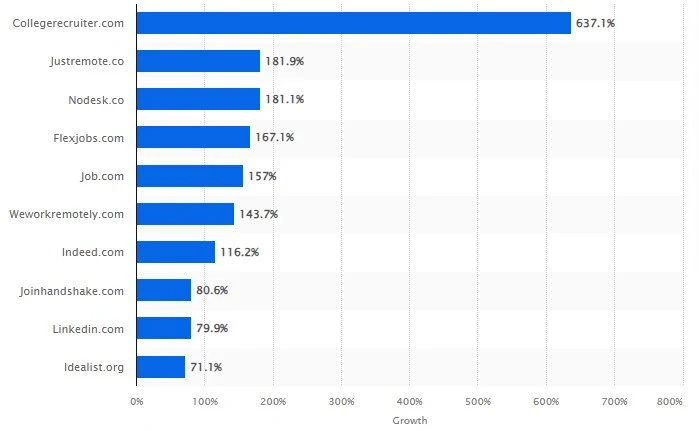
- Global Recruitment Software Market Size Worth US $ 3,095.8 million is expected to surge at 7.4% CAGR by the Forecast Period of 2019 to 2025.

- During January 2021 and March 2023, college recruiter became the fastest-growing job search site worldwide with a global traffic increase of over 637% during the measured period.
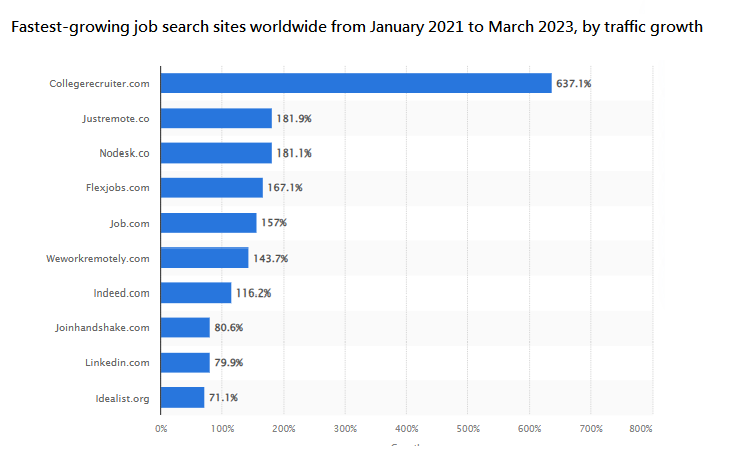
- Followed by college recruiter, Justremote.com, Nodesk.com has achieved a growth of 181.9% and 181.1% in the past three years.
- In the first half of 2022, Indeed was the most downloaded job search platform with over 40% of downloads, followed by LinkedIn with 34% of downloads.
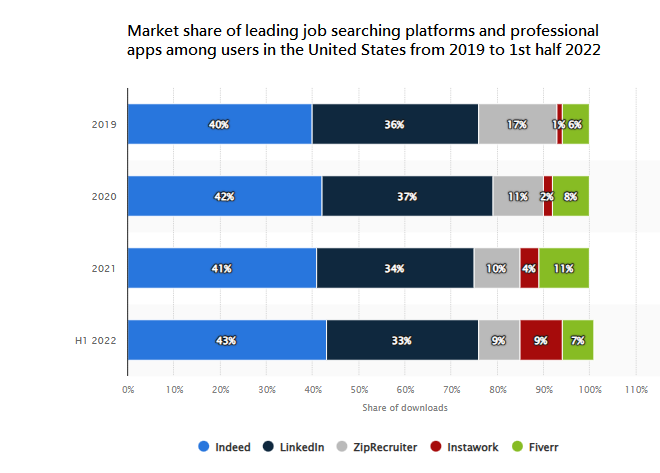
- LinkedIn has generated over 6.44 billion U.S. dollars in revenue from users, who have subscribed to premium accounts 3.95 billion U.S. dollars in other revenues, and 5.93 billion U.S. dollars in revenue from advertising.
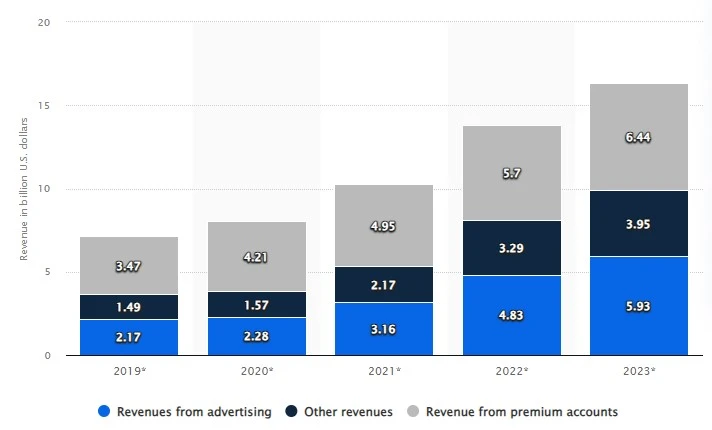
- In April 2024, LinkedIn had an audience reach of 230 million users in the United States. The country has the largest users with a runner-up India having an audience of 130 million.
Well, now you are aware of the revenue generation in the concerned field along with the number of popular job portals and their increasing number of users. You might be thinking of, does all job portals appear to be similar and function accordingly.
There are multiple types of job portals, let’s learn about them together in the next section.
Types of Job Portals
In this section, you will get to know the details related to different number of job portals that can help you to decide the type that will suit your demand.
It will also add to developing a job portal. Here is a detailed list.
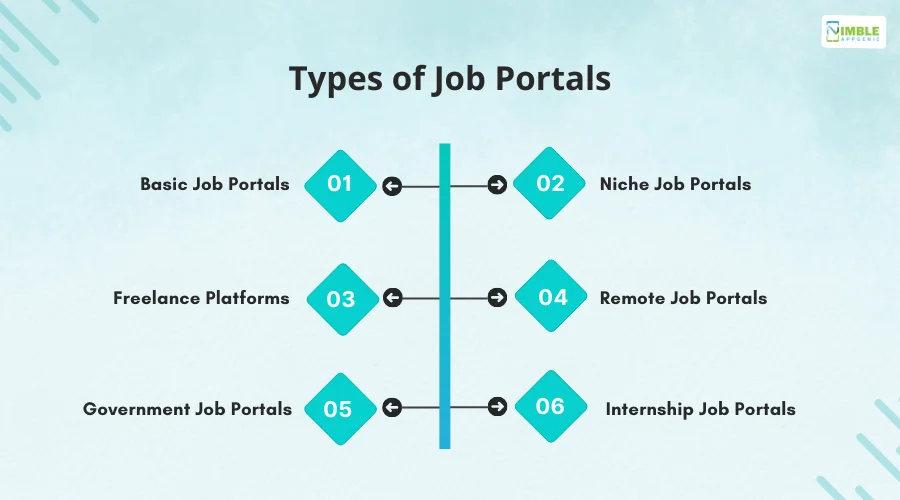
1: Basic Job Portals
Basic job portals cater to a wide range of industries and job types that offer diverse job listings across various sectors. Examples include Indeed, Glassdoor, and ZipRecruiter.
These are general job portals that contain diverse job listings, user-friendly features, job alerts and notifications, employer services, and resume-building tools.
2: Niche Job Portals
These platforms are specialized in particular industries, professions, or demographics that can cater to individual needs with specialized skills. For instance, Nurse.com, Dice, and Idealist.
Niche job portals have specified features that help the users to focus on one particular solution.
3: Freelance Platforms
The freelance platforms are built to connect freelancers with clients seeking short-term projects or contract work. For example Upwork, Freelancer, and Fiverr.
Such platforms are built to facilitate communication, project management, and payment procedures between freelancers and clients.
4: Remote Job Portals
Remote Job Portals focus on remote and telecommuting job opportunities that allow individuals to work from anywhere with an internet connection.
Here individuals can be part-time workers and seek a job that is fragile and provides them the opportunity to work remotely. Examples include We Work Remotely, and FlexJobs.
5: Government Job Portals
Government Job Portals are operated by government agencies and list job openings within the public sector. Examples can include USAJOBS (USA), Civil Service Jobs (UK), and MyGov (India).
The major consideration of such platforms is to serve the country and not to earn money.
6: Internship Job Portals
Internship Job Portals are focused on delivering the service to find an internship program. It is specifically designed for college students to practice their learnings.
These platforms connect the students with the companies that offer learning opportunities. Here users can find temporary jobs that can help them to learn and prepare for their future careers.
Types are discussed to help you decide on the best recruitment platform to trust. Switch to the next section to learn how these portals work.
How Does a Job Portal Works?
In the guide on creating a job portal, you have learned the concept, market statistics, and types of job portals.
Now, it’s time to know the workings of job portals. Check out the stepwise process (stages) related to general job portal workings.
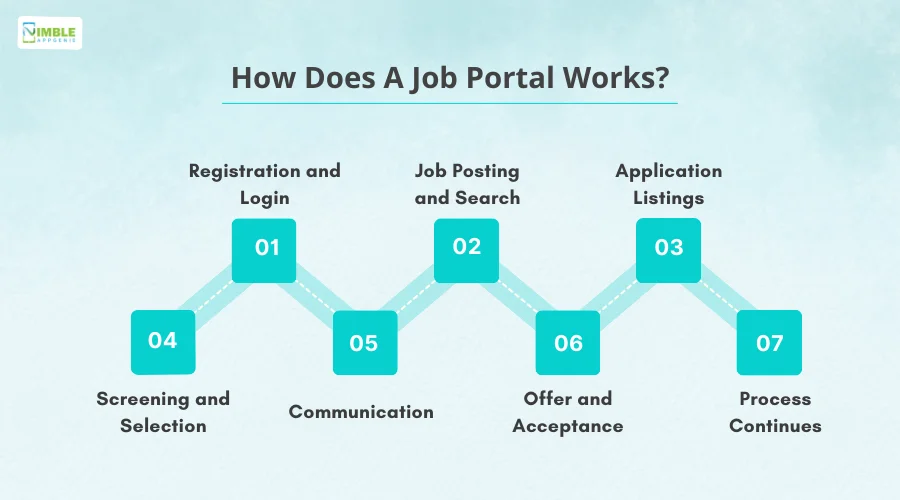
➤ Registration and Login
Here job seekers and employers create their accounts on the portal, providing necessary information such as personal details, job preferences, and professional qualifications. Authentication is just a by-product here.
➤ Job Posting and Search
Employers can post job openings on the portals that may include job titles, descriptions, requirements, and locations. They can specify the details regarding the same. Job seekers use the portal’s search functionality to browse through available job listings.
➤ Application Listings
In this step, the job seekers post the applications to their defined and targeted companies. The platform then lists their applications based on their profiles. This also helps employers to find the authentic candidate by observing the job profiles.
➤ Screening and Selection
Screening and selection is the step where the applications are filtered out with the help of software that can be applied by employers and company owners. Here the recruiters can conduct interviews and assessments to further evaluate potential candidates.
➤ Communication
Further in this step, employers contact the job seeker whose application has been screened and selected. Communication takes place between the two parties. Employers state the company’s rules and policies as well as listen to the conditions of the job seekers.
➤ Offer and Acceptance
Here the candidate evaluates the types of applications and then selects the most suitable option. The negotiation takes place based on the terms and conditions before accepting the offer digitally.
➤ Process Continues
The given steps continue further. In such a way different and a vast number of candidates search for jobs daily and these platforms provide a solution to employers and job seekers.
Why Create A Job Portal?
Before learning how to create a job portal, let’s know why to develop it.
Prior to how why is the step? You are ready to head on to this section as you have a good understanding of different types of job portals and their working procedure. Shall we proceed?
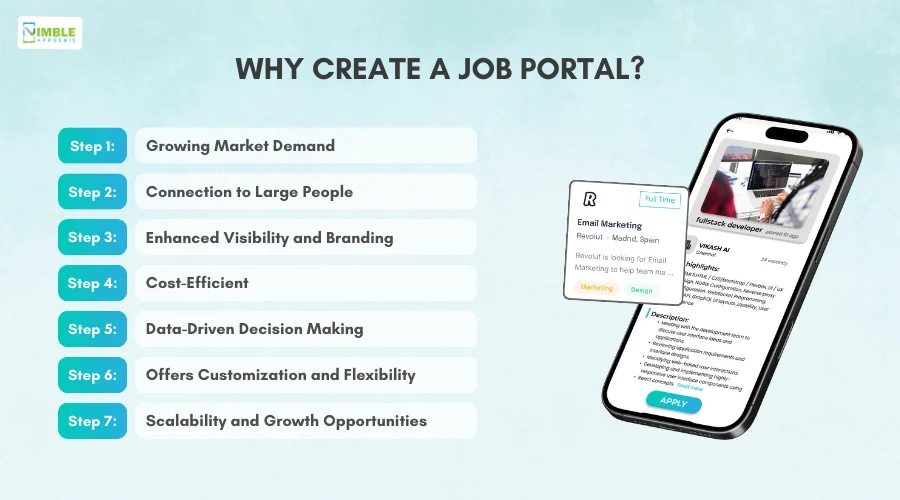
1. Growing Market Demand
Online recruitment market size and demand can hit US 58 billion dollars by the year 2032. This represents the growing market demand for job recruitment portals. The growing trend is an opportunity for you to enter the market and increase your revenue.
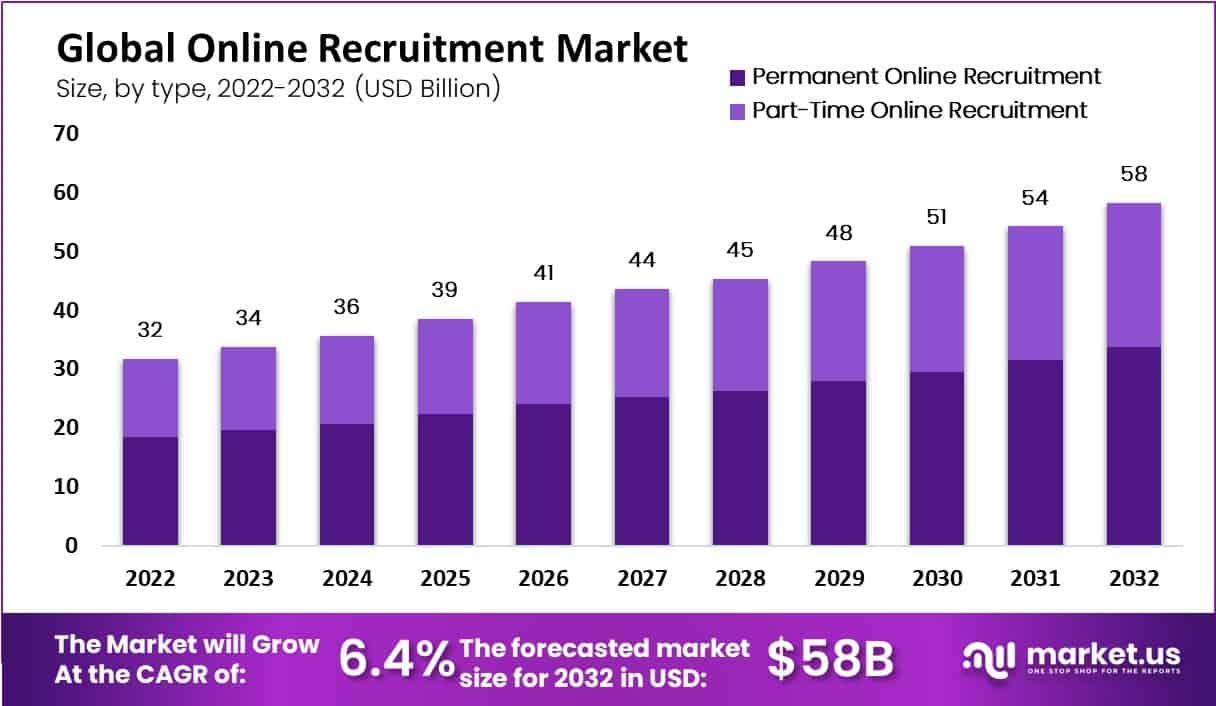
2. Connection to Large People
The current number of users of the LinkedIn portal is 230 million in the United States. And that’s the calculation of only one country. Now, think about its approach to the target users at the global level. By developing a successful recruitment platform like LinkedIn, you can aim to connect a large population.
3. Enhanced Visibility and Branding
When you already have a recruitment agency, developing a job portal will add to your branding and make you visible to a large number of audience. It assists employers to showcase their brand visibility, by attracting the top talented candidates.
4. Cost-Efficient
Developing a recruitment platform is more cost-efficient rather than developing hoardings or making the vacancies print over the newspapers. It also helps you to adopt the current trend of digital marketing and to connect with the target users online.
5. Data-Driven Decision Making
Build a job portal that can help users to find vacancies based on the data. For example, LinkedIn uses data and analytics to make informed strategic choices by guiding you to make the most- informed decisions that can help in your career-building process.
6. Offers Customization and Flexibility
Customization is the prominent trait that helps website users evaluate the results of posting their applications to find a job. It offers flexibility to employers to find a suitable candidate at a global level or within a limited location based on the requirements of the job position.
7. Scalability and Growth Opportunities
Developing a job board website can increase your scalability and can offer you multiple business opportunities. It allows you to interact with new candidates and employers helpful to build a wide connection as well as to adapt to the changing dynamic market.
Here you have understood the need to make a job portal. Read out about the top job portal websites in the further section.
List of Top Job Portals
Now, as you know a detail about the job portal, its current market scenarios, types, and the requirements to make a suitable recruitment platform. Here’s a list of the best job portals that can provide you an inspiration to get ahead with the development of the platform.
In the given list, you can find Indeed alternatives helpful to evaluate platforms leading the world of recruitment. Let’s begin to read the famous job portals.
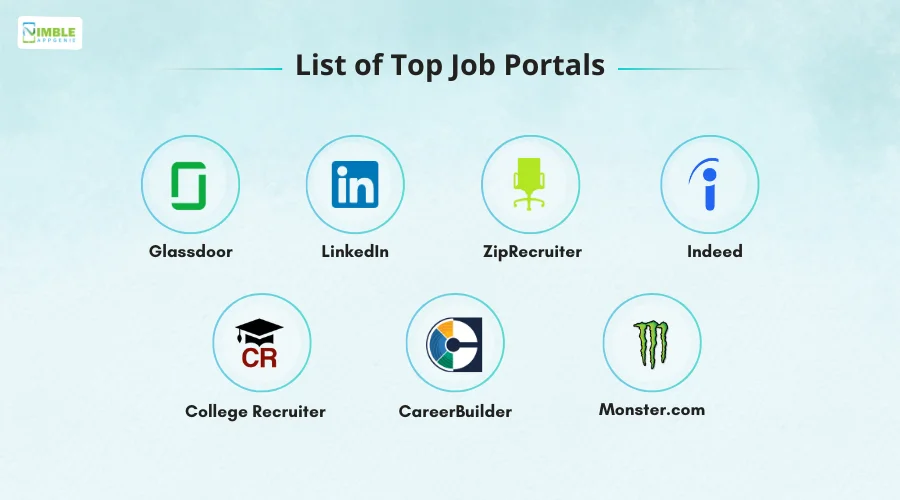
► Glassdoor
Glassdoor empowers job seekers with straight-from-the-right source insights, reviews, and intel so that the candidates can find a suitable career path. To make a platform like Glassdoor, you can analyze its features attracting a large number of users.
Here an individual can find the company’s reviews and ratings. This can be helpful to them in gaining valuable insights related to the company’s culture, salary, and much more.
Every day, people search on the LinkedIn platform and find suitable jobs that match their needs. LinkedIn job search boosts the chances of enhancing your career and getting hired through networking.
Professional networking helps the users to attract recruiters and hiring managers, as well as increasing the likelihood of being contracted for relevant job opportunities.
► ZipRecruiter
ZipRecruiter is a user-friendly platform designed to simplify the job search process by making it efficient and effective. It helps small businesses to post job listings affordably. It is an online employment marketplace that acts as an epitome of professional networking.
Here the users are being asked screening questions to make job search easier for USA applicants.
► Indeed
Indeed is among the best platforms in the world to recruit candidates with over 350M+ unique visitors every month. The platform strives to put job seekers first and provide them access to search for jobs, post resumes, and research for companies.
Here individuals can search millions of jobs online to find the next step in their career. To make a platform like Indeed, you should be aware of its features such as Indeed Apply.
► College Recruiter
College Recruiter believes that every student and recent graduate deserves a great career. The company has been in business for over three decades which proves their ability to embrace the new technologies to deliver exceptional results to our employer customers.
This platform is built for the freshers who struggle to find jobs after completing their degrees and courses.
► CareerBuilder
CareerBuilder is one of the promising platforms and is a company among Fortune 500, to look into for new career opportunities and for all remote employees. The platform has two big points in its favor size and longevity.
The platform is focused on helping you target and attract the candidates you need and making it easier for you to do business successfully.
► Monster.com
Monster.com is a global employment website that was a merger between Monster board and an online career center. This website has been connecting job seekers and recruiters for the past two decades. The company was among the first to introduce the business of online recruiting.
It connects job applicants and employers efficiently over the Internet. This platform is a global leader in making every workplace happier and more productive.
Now as you are aware of the top job portals, do you want to know what makes them best? Well, it’s all about features that make the platform unique and successful in the competitive market.
What are the Key Features of the Job Portal?
Till now, you have read the market statistics, concepts, types, working processes, and top apps. Now if you’re wondering when we will come to address how to create a job portal.
Well, in the next section, you will get it. But, before that learn about the key features that can make your job portal unique and diversified. The given list will say it all.
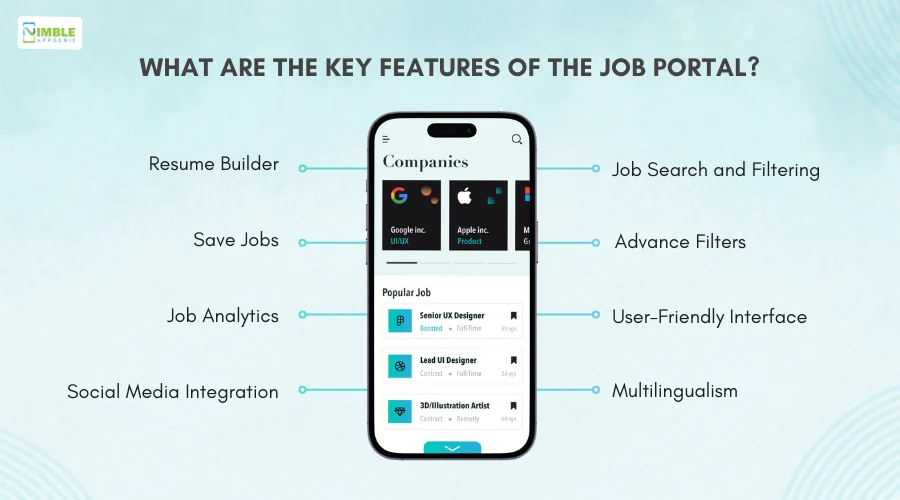
1] Resume Builder
This feature empowers job seekers with an integrated resume builder that simplifies the process of developing and formatting professional resumes. Here users can create profiles where they can upload resumes to showcase their skills and learnings.
2] Job Search and Filtering
Here users can search for job search which is based on criteria such as location, industry, job title, experience level, and salary range. The advanced filtering options help the users to find relevant opportunities more efficiently.
3] Save Jobs
The job portal website helps the users save their favorite jobs that they already navigated through and can bookmark the jobs to refer them back when they need to look at them. This feature assists portal users in revisiting the jobs when they are interested in applying.
4] Advance Filters
This feature is effective in identifying the job that the users actually want. You can make use of advanced technology to add filter options to make a job portal. With the advanced features and search options, users can narrow down their search by adding different features.
5] Job Analytics
Job analytics enables job portal users to assess resume databases, job postings, and user profiles to share them with third-party partners. The employer’s analytics feature empowers the admin to view and analyze the list of employers utilizing the benefits of the job portal.
6] User-Friendly Interface
One of the features that you should consider while developing a job portal is a user-friendly interface. Here you should consider that not every one of them is tech-savvy. Thus, try to keep the features simple and easy to navigate.
7] Social Media Integration
Nowadays, social interaction has become one of the essential points to consider while creating an SEO-friendly website. Social media visibility plays a large role in reaching the right candidates. Sharing the job with friends and family over media networks such as Facebook, and WhatsApp creates connectivity.
8] Multilingualism
Here the term multilingualism is related to adding multiple languages. Well, English has become a global language, and still providing the feasibility to find jobs in their regional language can create a unique path for you to sustain the competitive market.
In the ultimate step-by-step guide to Job Portal development, it’s time to know the steps that can aware you of the development process.
How to Create a Job Portal?
After the features, in the guide to Job Portal platform development, here is a procedure to develop a job portal.
Here is a step-by-step guide to Job Portal development. You can look at them one after the other. Let’s start.
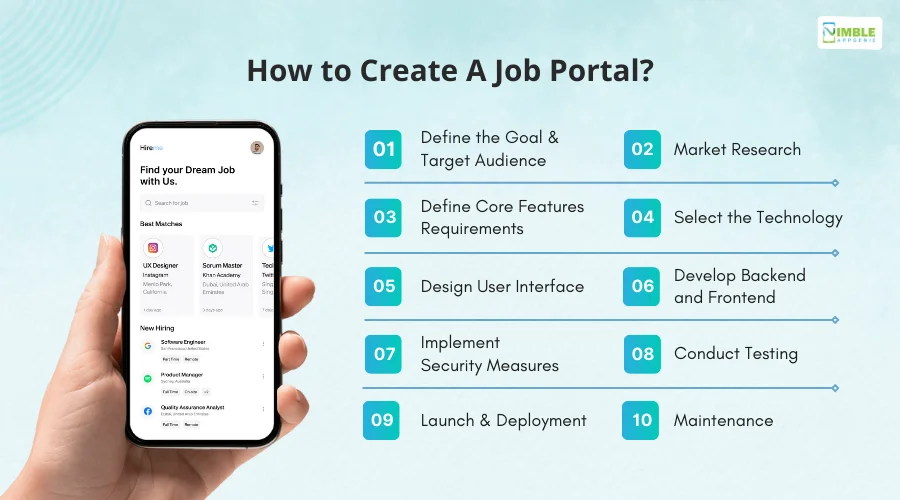
1. Define the Goal and Target Audience
This is the first step, where you begin with defining the goal as well as the target audience. Here you have to determine the type of job portal you want to develop. The aim of developing a portal should be clear as it is the foremost step to developing a job portal.
2. Market Research
You should perform market research to understand the needs and preferences of the target users. Here you should analyze the unique selling point of the current best recruitment apps. This evaluation will be helpful in optimizing the performance of your job portal.
3. Define Core Features Requirements
Based on your research, you should define the features that will be the basic and advanced features for the job portal. These features can include job search functionality, resume upload, and employer account management that will ultimately define your type of job portal.
4. Select the Technology
Now, it’s time to identify the type of essential tech stack suitable for your job portal. Technology will be useful in deciding scalability, security, and development expertise. Here you should consider technology with the help of frameworks and tools such as PHP, Ruby on Rails, etc.
5. Design User Interface
You need to select the type of design and framework that can help create attractive UI/UX design. Here you should focus on developing a seamless user experience for both the job seekers and employers.
6. Develop Back-End and Front-End
Integrate with third-party services or hire white-label PPC services agencies for payment gateways, email service providers, analytics tools, and social media platforms to enhance their functionality and reach the target audience. You can hire website developers for this process.
7. Implement Security Measures
Here in this step, you should secure your job portal by implementing measures such as data encryption, secure authentication methods, regular security audits, and compliance with data regulations. With robust security measures, you can enhance your job portals’ security.
8. Conduct Testing
Prior to launching the job portal, remember to conduct testing. Here you should develop to enable successful testing measures. A thorough testing of the portal can help fix bugs, errors, or usability issues.
9. Launch and Deployment
Once testing is complete, launch your job portal. You should deploy it for a reliable hosting platform or cloud service provider to ensure scalability, reliability, and performance under varying levels of traffic.
10. Maintenance
Job portal maintenance is one of the ongoing steps. Identify the need for maintenance and implement this process to stand out in the competitive environment. Addressing user inquiries, updating features, fixing bugs, and keeping the platform secure.
With a complete guide to job portal development, you might have the right technique to make your job portal. Let’s get ahead to know its cost of development.
How Much Does it Cost to Make a Job Portal?
Now, as you got to know a detail of how to make a job portal, there can be another question related to cost and time.
This section will address both of your queries.
The average cost to make a job portal can range from $20,000 to $60,000. However, the costs can vary depending on factors such as complexity, website design, tech stack, and platform and development team.
Let’s discuss the time of creating a job portal. You can check the given table to learn about the timeline.
Sure, there’s an estimated time breakdown for creating a job portal:
| Aspect | Estimated Time |
| Requirements Gathering | 1-2 weeks |
| Planning & Analysis | 2-3 weeks |
| Design & UI/UX | 3-4 weeks |
| Back-End Development | 4-6 weeks |
| Front-End Development | 3-5 weeks |
| Third-Party Integration | 2-4 weeks |
| Testing & QA | 2-3 weeks |
| Deployment & Launch | 1-2 weeks |
| Total | 18-29 weeks (approximately 4.5 to 7 months) |
Here you will find that the approx. time is 18-29 weeks.
Effective Monetization Models to Earn Money
After understanding the cost of investing in job portal development, let’s learn some ways to earn money after portal development.
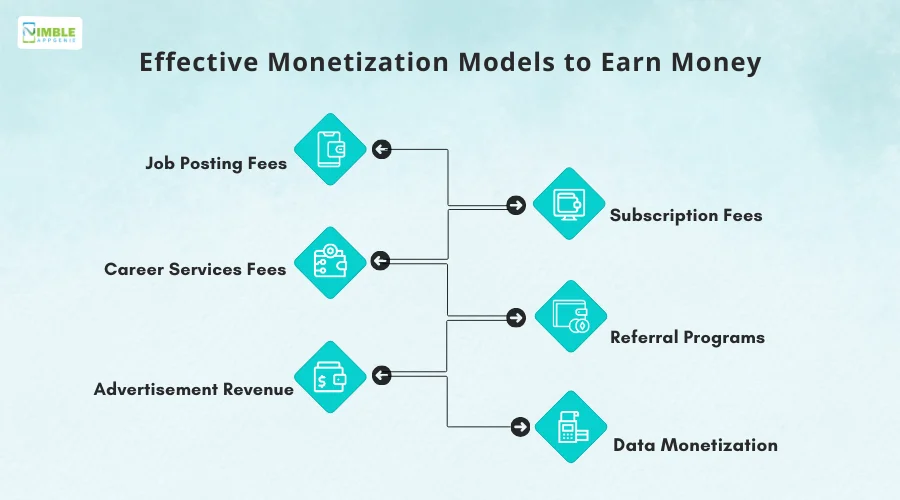
♦ Job Posting Fees
This is the most common type of model to earn money while creating a job portal. However, every job board has its own rules and regulations, thus you should read them all before deciding on the job posting fees.
♦ Subscription Fees
When employers pay a monthly subscription to find the right candidate over the platform, this creates an income source for the job portal. This method creates convenience for employers to hire candidates. Here you can create customized plans for such employers.
♦ Career Services Fees
You can provide professional consulting to job seekers to achieve their dream job. To avail of this service for the users, you can charge an extra amount. In this type of service, you can enable different types of plans whose range varies depending on the consulting you provide.
♦ Referral Programs
Referral programs can be useful to help your loyal users earn a commission and for you, it can act as a step to link the most prominent and target users. You can ask the users to refer the job portal who have got their dream job or have found a candidate via your portal.
♦ Advertisement Revenue
The advertisement model is being adopted by several popular portals including Glassdoor and LinkedIn. Here you can generate revenue with the assistance of targeted advertising on your job portal and displaying ads from third-party advertisers to increase website traffic.
♦ Data Monetization
You can use this model by analyzing a wide amount of data that can be helpful to employers looking for the right candidate for their company. Here you should note that the data needs to be collected and analyzed after getting consent from the website users.
Challenges Faced While Developing a Job Portal
After learning the process of creating a job portal along with the cost and monetization models. Although, there can be certain mistakes that should be avoided to enhance the overall performance of the portal.
Want to know them all? Check the list below.
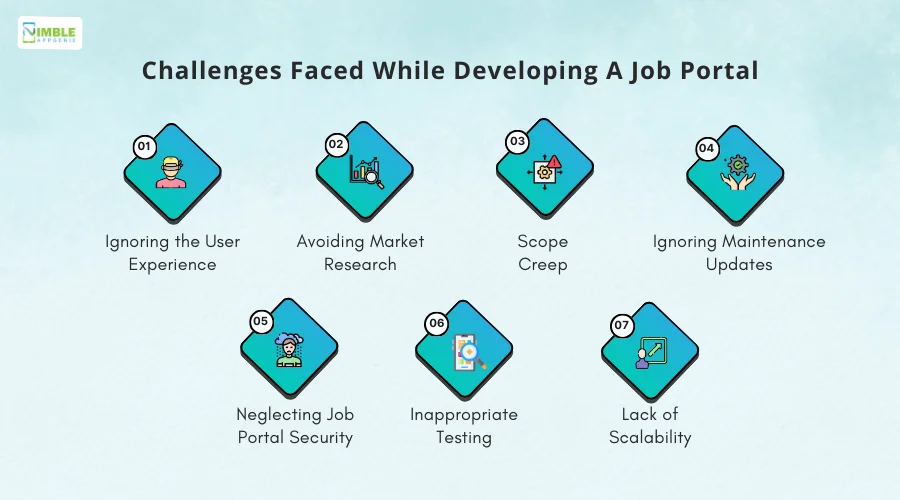
• Ignoring the User Experience
User experience plays a crucial role in enhancing the success of the job portal. If you avoid making a portal that engages the users then you automatically fail to address the needs of target users.
• Avoiding Market Research
Poor market research can even impact the overall brand image. It can result in confusion built over deciding the target user base. Hence you should not overlook market research.
• Scope Creep
When you hire a website development company discuss all the details related to your job portal prior. An unnecessary addition of features to the portal can create delays in launching it.
• Ignoring Maintenance Updates
Website maintenance and regular updates play an important role in the creation of a job portal. Ignoring such a step can make your portal fail. It can even result in losing all your earned brand image.
• Neglecting Job Portal Security
Security plays an essential role in ensuring the success of the portal. When you ignore portal security, you have a chance of losing your users. Data security should be considered here.
• Inappropriate Testing
Testing can make your portal and it can even lead to a downfall. Then what should you avoid? Here you should keep in mind testing of the job portal before you launch it.
• Lack of Scalability
Scalability avoidance can impact your overall performance of the job portal. Here you should be a wide thinker with relation to improving scalability so that the platform can handle increased traffic.
Best Practices and Current Trends to Make a Job Portal
In the Job Portal platform development guide, this is the last section.
Want to know ways to make your job portal as per current market trends? Here you go. Read out a list related to the best approaches to develop an online job portal.
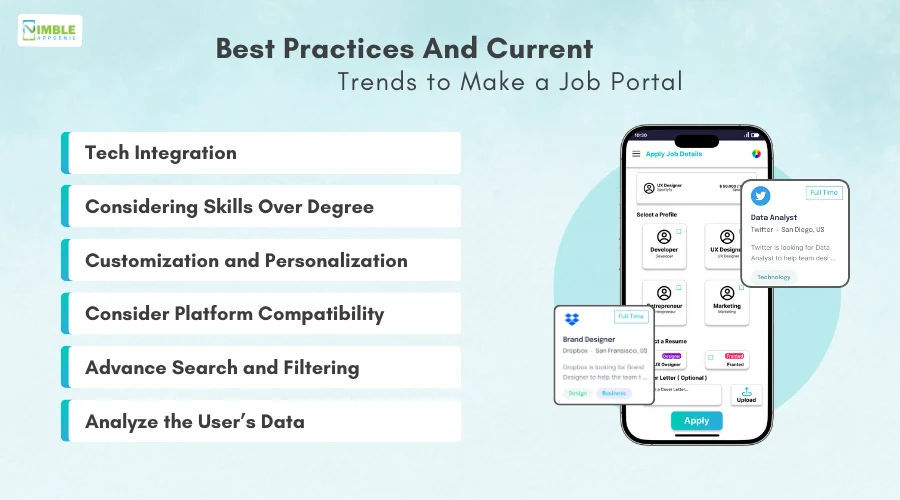
► Tech Integration
With the growing usage of artificial intelligence (AI), it has become mandatory for you to design the job portal accordingly. You can design the features of the portal in a way that can enhance users’ experience.
► Considering Skills Over Degree
You can design the job portal in a way that it should consider the skills of the candidate foremost than their degree. It will be helpful to the portal users to search out for a company that considers skills as a superior component.
► Customization and Personalization
This is a system that can be helpful in increasing user engagement by using customization as well as a personalization model. You can incorporate personalization features such as recommended jobs, custom job alerts, and others to meet the needs of users.
► Consider Platform Compatibility
Platform compatibility is one of the options that should be considered for ensuring the growth of the job portal. Here you can develop a platform that can cater to the needs of the recruiters as well as for the job seekers.
► Advance Search and Filtering
You can implement the advanced search option in your job portal by offering users to narrow down their job listings for the criteria based on location, job level, type, etc. This filtering option can improve the user base by implementing natural language processing and machine learning.
► Analyze the User’s Data
Use the collected data from the users to analyze the information required to tailor the needs and preferences of the target audience. This can assist you in generating a more authentic user base that can increase your website’s presence in a competitive market.
How Can Nimble AppGenie Assist You With Creating a Job Portal?
With the guide to creating a job portal, you can initiate its development process. However, without a team it’s impossible. If you are in trouble selecting the right company to develop a job portal, then here is a complete solution.
Collaborate with Nimble AppGenie, we have expertise in creating a successful job portal that can fulfill the needs of the target users.
We are the best Job Portal Development Company helpful to you for enabling logic-based and trending features as per your dream portal.
Conclusion
Creating a job portal is a strategic venture that demands strategic planning, market understanding, and adherence to industry best practices. By following a comprehensive guide, you can embark on this journey confidently.
Understanding the concept, market statistics, and various types of job portals is fundamental. Initiating with defining the goal, conducting thorough market research, and outlining core feature requirements sets the foundation.
Selecting appropriate technology, designing an intuitive user interface, and implementing robust backend and frontend development are pivotal steps. Security measures, testing, and deployment ensure a seamless user experience.
Monetization models like job posting fees, subscriptions, and referral programs offer revenue streams. Challenges like neglecting user experience and scalability must be addressed. Embrace current trends with best practices in your job portal.
FAQs
To create a job portal, you need to start by defining your goals and target audience. Conduct thorough market research outline core features, select appropriate technology, design an intuitive UI/UX, and develop robust backend and frontend. Implement security measures, and focus on maintenance and updates.
A job board website is a platform where employers can post job openings and job seekers can search for and apply to those jobs. These websites serve as a medium for connecting employers with potential candidates, offering features like advanced search filters, resume-building tools, and job alerts.
Job portals come in various types including basic job portals, niche job portals, freelance platforms, remote job portals, government job portals, and internship job portals. Each type caters to specific industries, professions, or demographics, providing tailored solutions for both job seekers and employers.
Developing a job portal offers several benefits including tapping into growing market demand, connecting with a large audience, enhancing visibility and branding, cost efficiency, data-driven decision-making, customization, scalability, and growth opportunities.
Key features of a job portal include a resume builder, job search and filtering, saved jobs, advanced filters, job analytics, a user-friendly interface, social media integration, multilingualism, and more. These features enhance user experience and increase the platform’s effectiveness.
The cost to make a job portal can range from $20,000 to $60,000, depending on factors like complexity, design, technology stack, and development team. The time required for development typically ranges from 4.5 to 7 months.
You can monetize your job portal through various methods including job posting fees, subscription fees, career services fees, referral programs, advertisement revenue, and data monetization. These revenue streams can help sustain and grow your platform.
Challenges in developing a job portal include ignoring user experience, market research, scope creep, maintenance updates, neglecting security, inappropriate testing, and lack of scalability. Overcoming these challenges is crucial for the success of the portal.

Niketan Sharma is the CTO of Nimble AppGenie, a prominent website and mobile app development company in the USA that is delivering excellence with a commitment to boosting business growth & maximizing customer satisfaction. He is a highly motivated individual who helps SMEs and startups grow in this dynamic market with the latest technology and innovation.
Table of Contents




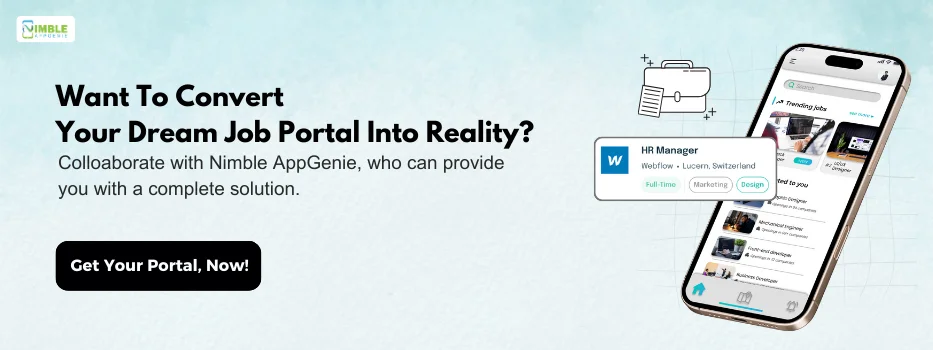
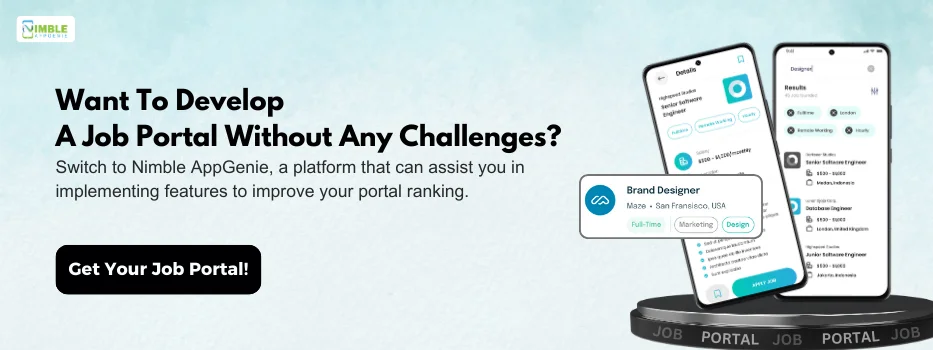
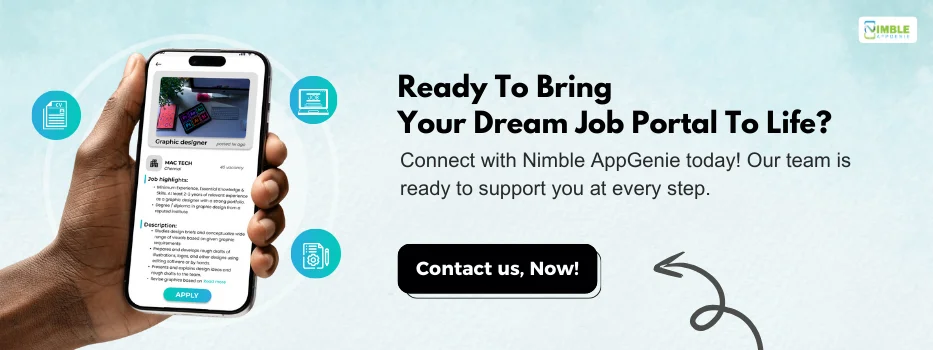
No Comments
Comments are closed.